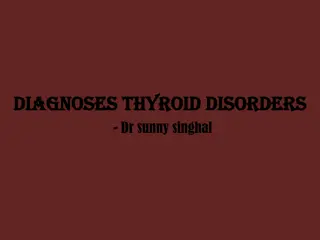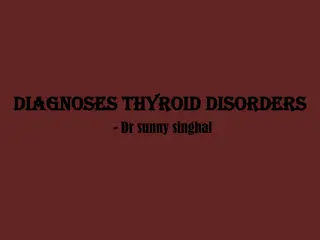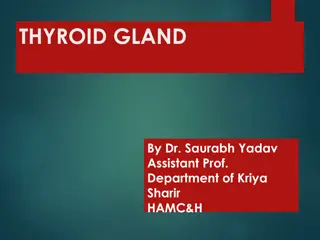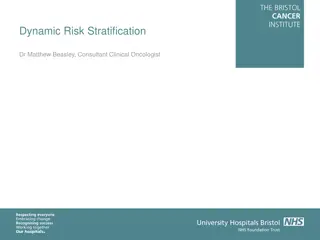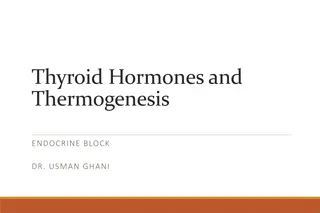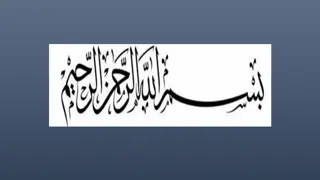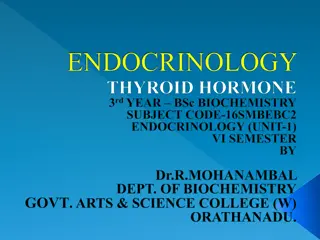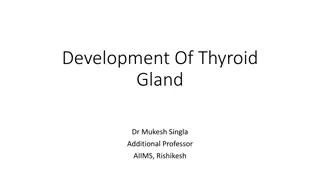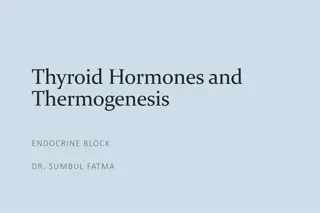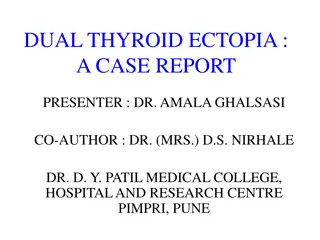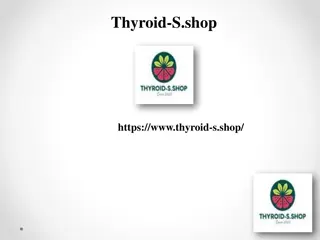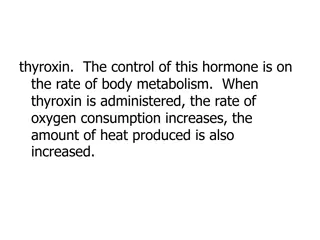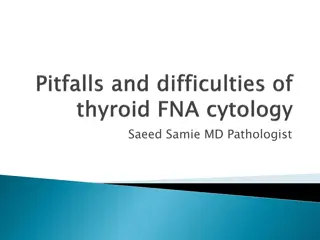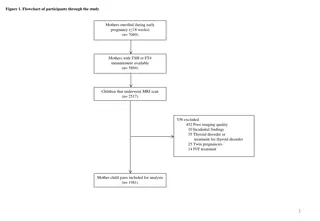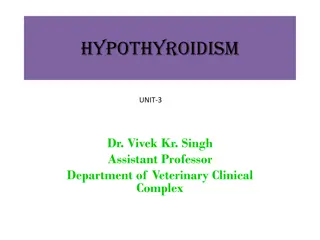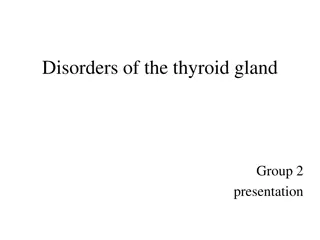Understanding Thyroid Disorders in Children - Clinical Case Study
This clinical case study focuses on a pediatric patient presenting with abdominal enlargement and a history of delayed development. Key aspects covered include birth and maternal history, immediate postnatal course, developmental milestones, and past medical history. The diagnosis process involves considering congenital hypothyroidism, prompting questions about birth history, neonatal health, feeding habits, jaundice, bowel movements, developmental milestones, growth, and dentition. The patient's familial and social background is also explored to provide a comprehensive understanding of the case.
Download Presentation

Please find below an Image/Link to download the presentation.
The content on the website is provided AS IS for your information and personal use only. It may not be sold, licensed, or shared on other websites without obtaining consent from the author. Download presentation by click this link. If you encounter any issues during the download, it is possible that the publisher has removed the file from their server.
E N D
Presentation Transcript
Thyroid Disorders in Children Lorna F. Ramos-Abad,MD Professor of Pediatrics August 8,2020
Clinical History JF, 8 years 11 months old boy Chief Complaint: Abdominal enlargement
History of Present Illness Birth/Maternal History Born term to a 22 y.o. G2P1(1-0-0-1) NVSD At home ,assisted by a midwife (-) complications Irregular prenatal check-ups at a LHC No significant illnesses during pregnancy/no intake of teratogenic drugs
Immediate Postnatal course good cry , Good activity Good suck (-) jaundice Had urine output on the first day Breastfed after 2 hours from birth
History of Present Illness 5 months old: Noted delayed development compared to sibling No consult done 8 months old: consult at PGH OPD abnormal:malaki ulo, dila, delayed development Unrecalled laboratory examination requested Lost to follow up
History of present illness 1 day PTA (-) BM, flatus (+) abdominal enlargement (+) abdominal pain (+) 1 episode of vomiting (+) progression of abdominal enlargement Consult at local Hosptial Referred to PGH
Review of Systems (please Answer) What questions will you ask if you are considering congenital hypothyroidism?
Questions to ask Birth Hx Neonatal History Feeding (frequency) Jaundice Bowel movement Developmental History Growth Dentition
Past Medical History: unremarkable Family Medical History: no heredo- familial disorders Personal/Social History: 2nd of 5 children Mother is a 32 y/o housewife Father is a 34 y/o driver All siblings apparently healthy Does not go to school
Developmental History Social smile: 3mos Rolled over: 1 yr 2 mos Sat with support: 5 years Crawled: 5 years Sat alone: 6 years Stood with support: 7 years sat alone: 7 years Cruised: 8 years
Babbles: 5-9 months 1stword ( papa ): 5 years At present: Can stand/walk with support Cooperates with dressing Can undress himself Can point to what he wants Has a 2-word vocabulary Attempts to feed himself
Physical examination Awake, irritable ,pale Vital Signs: HR: 80/min. RR:30 bpm Temp: 37.4 cm Wt: 17 kg Ht: 83 cm HC: 54 cm Abd Girth: 55.5 cm (umbilicus) 63.5 cm (widest diameter)
Fathers height: 177.8 cm Mother s height: 161.29 cm MPH: 163.05 cm Weight-age: 4 years old Height-age: < 2 years old F M
SKIN: Pale skin , dry , fair turgor HEAD: open anterior fontanelle (3x3 cm) EYES: Pale palpebral conjunctiva (-) TPC. (+) multiple dental carries, (+) macroglossia (+) low nasal bridge (-) anterior neck mass
Chest and Lungs: Symmetrical chest expansion,clear breath sounds, no rales or wheezes,no retractions Heart: no precordial bulge , heaves or thrills Apex beat: 4th ICS Left MCL Distinct heart sounds Regular rate and rhythm No murmurs
Abdomen : Distended (+) umbilical hernia AG: 55.5 cm (umbilicus), 63.5 cm (widest diameter) Hypoactive bowel sounds (+) direct tenderness all over Soft (-) rebound tenderness
ExtremitiesExtremities: Full and equal pulses , no cyanosis , No edema, no clubbing CRT< 2 seconds GENITALIA: Grossly male Phallus: 4.5 cm testicular volume : 2 ml Tanner s stage 1 NEURO Exam: Essentially normal
Initial Assessment Ileus probably secondary to Congenital Hypothyroidism
Points for discussion: 1)Do you agree with the impression? 2)What are the salient features that point to possible congenital hypothyroidism?
1. Explain the clinical manifestations 2.What are the possible causes of the congenital hypothyroidism? 3.What work-up will you request? 4. What will you advise regarding thyroid hormone therapy? 5. What is the prognosis? 6. Can you prevent mental retardation in cases of congenital hypothyroidism?
Salient Features 8 years 11 month old male Global developmental delay With an 8 year history of constipation PE: Pallor Patent anterior fontanelle Macroglossia Low nasal bridge Abdominal distention Umbilical hernia Hypoactive bowel sounds Direct tenderness
1. Explain the clinical manifestations 2.What are the possible causes of the congenital hypothyroidism? 3.What work-up will you request? 4. What will you advise regarding thyroid hormone therapy? 5. What is the prognosis? 6. Can you prevent mental retardation in cases of congenital hypothyroidism?
Clinical Data o K.R. ,5 year old female o Chief complaint: anterior neck mass o History of Present Illness: o1 month PTA : gradually enlarging anterior neck mass ,bulging of both eyes o tremors of both hand o increase bowel movement to 2-3 x/ day o palpitations and dyspnea
Clinical Data o Consulted private MD : o Impression : Goiter o Seen at PGH-OPD: o soft, diffuse anterior neck mass measuring 4 x 3.5 x 0.5 cm o tachycardic at 140/min o Work up requested
Review of Systems (-) weight gain/loss (-) rashes (-) loss of consciousness (-) headache (-) sore throat (-) cyanosis (-) jaundice (-) bleeding (-) pigmentation (-) seizure (-) vomiting (-) aural discharge (-) fainting spells (-) constipation (-) urinary changes (-) fever
o Past Medical Hx: o Family Medical Hx: o Birth/Maternal History: o Nutritional Hx: o Immunization Hx: o Developmental Hx: o Personal/Social Hx Non-contributory
Pertinent Physical Exam Findings Awake, irritable, in respiratory distress BP: 100/70 CR: 170/min RR: 40/min Temp: 39.3 C Wt 12.25 kgs MPH 163 cm (Mother s ht 155 cm Warm moist skin, no active dermatoses Ht: 95 cms Father s ht 172 cm)
Height: 95cm Mother:155 Father: 172 MPH 155+172 2 - 6.5 (Ans:157) Mother Father
Pertinent Physical Exam Findings o Pink palpebral conjunctivae, anicteric sclerae, (+) exophthalmos o (+) anterior neck mass, soft measuring 4 x 2 x 0.5 cms. , poorly delineated, non- tender, moves with deglutition, no bruit o symmetrical chest expansion, o (+) intercostal retractions, harsh breath sounds, (+) rales on both lung fields, (-) wheeze
Pertinent Physical Exam Findings o CVS: adynamic precordium, AB at 4th L ICS MCL, distinct HS, tachycardic, normal rhythm, no murmurs o globular abdomen, normoactive bowel sounds, soft, non-tender, no masses, no organomegaly o grossly female genitalia o no edema, no cyanosis, full and equal pulses
Neurological Examination o Awake, alert o Pupils 2-3 mm equally briskly reactive to light o Fundoscopy: (+) ROR, OU; clear media, distinct disc border o Full EOM s; Brisk corneals o No facial asymmetry o Intact gross hearing o Good gag
Neurological Examination o Tongue midline o Motor: 5/5 on all extremities o Sensory: no deficits o DTRs ++ on all o No babinski, no clonus o No neck rigidity o No nystagmus
Answer the ff: 1. What is the first step in evaluating children who present with anterior neck mass? 2. What important anatomical distinction should you do? 3. What laboratory tests will you request? 4. When do you do biopsy?
Answer the ff: 5) What medication will you give? Side-effects of treatment ? 6) What is the role of medical, surgical and radioactive therapy? 7) Will her condition affect future pregnancy?
Case Scenario (DKA) J.F. ,7 y/o , Female, Filipino ,Iglesia ni Cristo from Marikina City CHIEF COMPLAINT: generalized body weakness HPI: 4 weeks PTA: Fever ,Dysuria No cough/colds Consult private MD ; UA. -- UTI Cotrimoxazole 5 mkd x 7 days Paracetamol 10 mkd prn x fever
2 weeks PTA: Polyuria, Nocturia, Polydipsia 1 week PTA: appetite activity Weight loss FFup same MD CBC and SE: normal UA: UTI - Cotrimoxazole 5mkd x 7 days
3 days PTA: No improvement ,Occasional DOB , No fever/cough/colds Consult diff MD: ATP Cotrimoxazole shifted to Clarithromycin 15mkd Day of admission: DOB ,Weakness No vomiting. No abd pain Secondary hospital, Work-ups normal RBS: 23.8mg/dl UA: ph5, glucosuria 3+ IVF hydration
PHYSICAL EXAMINATION Awake, weak-looking, drowsy, in cardiorespiratory distress BP 70/40mmHg CR 110/min RR 30/m Temp 36.8C Wt 16 kg (z<-2) Ht 112cm (z<-1) 13 (z<-1) Warm dry skin, no active dermatoses Pink palpebral conjunctiva, anicteric sclera, sunken eyes,(+) alar flaring,, dry lips and buccal mucosa, Supple neck, no cervical lymphadenopathy BMI
Pertinent PE Symmetrical chest expansion, (+) mild subcostal retractions, Kussmaul s breathing,, clear breath sounds, no crackles, wheezes nor rhonchi Adynamic precordium, apex beat at 5th LICS MCL, tachycardic, regular rhythm, no murmur, no heaves, no lifts nor thrills Flat abdomen, normoactive bowel sounds, tympanitic on all quadrant, no tenderness, no organomegaly Grossly female genitalia, no vaginal discharge nor erythema Fair pulses, warm extremities, no edema, no cyanosis, CRT 3 sec
NEUROLOGICAL EXAMINATION Drowsy, follows command Cranial Nerves intact Cerebellar: nystagmus No sensory deficits Motor: Normal muscle tone, bulk, strength, can move all extremities equally and symmetrically DTR: ++ on all extremities No pathologic reflexes, No meningeal signs
Please answer the following Questions 1)Explain the signs and symptoms of our patient 2)Compute total serum osmolality, effective osmolality and anion gap 3)What is the true Na level of the patient? 4)Compute fluid requirement of the patient; fluid of choice?
Clinical Manifestations Nausea, vomiting abdominal pain Dehydration Warm dry skin sunken eyes dry lips and buccal mucosa Rapid, deep, sighing (Kussmaul respiration) (+) alar flaring Progressive obtundation and loss of consciousness
Questions: 1)Explain the signs and symptoms of our patient 2)Compute total serum osmolality, effective osmolality and anion gap 3)What is the true Na level of the patient? 4)Compute fluid requirement of the patient; fluid of choice?
LABORATORY CASE : : JF/7/F Serum Glucose 28.8 mmol/L Electrolytes Na124 K4.8 Cl95 Ca2.04 BUN 5.3mmol/L Creatinine 77umol/L VBG pH6.89 pCO2 12 pO2 33 HCO3 3.0 CBC Hgb142 Hct43 Wbc9.6 Seg78 Lymph17 Pltct259 sp.gr.1.023 ph6.0 glucose +4 ketone large no growth after 5 days incubation Urinalysis Blood Culture ECG normal
Serum Osmolality/AG Total serum Osm: 2(Serum Na) + RBS + BUN 2 (124) +28.8) + 5.3 = 282.1 Effective serum Osm:2(Se Na + K) + Glucose Anion gap: Na (Cl + HCO3) 2(124+ 4.8) + 28.8= 286.4 124 (95 + 3)= 26
Questions: 1) Explain the signs and symptoms of our patient 2) Compute total serum osmolality, effective osmolality and anion gap 3)What is the true Na level of the patient? 4) Compute fluid requirement of the patient- type of fluid 5) What is the corrected K level of the patient?
True Hyponatremia or spurios? Serum Na : 124 RBS:28.8 mmol/L (518.4 mgs/dl) 124 + (1.6 X 4)= 124 + 6.4=130.4 Decrease serum Na by 1.6 for every 100 mgs/dl sugar above 100
Questions: 1) Explain the signs and symptoms of our patient 2) Compute total serum osmolality, effective osmolality and anion gap 3) What is the true Na level of the patient? 4) Compute fluid requirement of the patient; fluid of choice?


